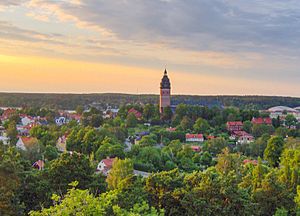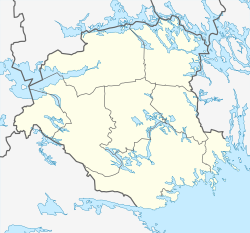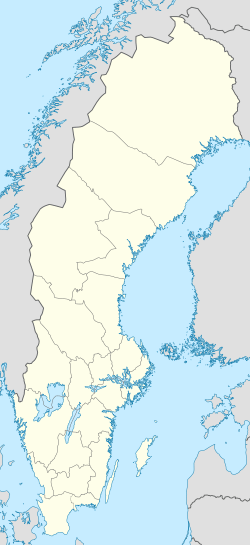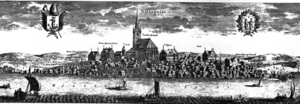Strängnäs facts for kids
Quick facts for kids
Strängnäs
|
|
|---|---|

Seen from the south
|
|
| Country | Sweden |
| County | Södermanland County |
| Municipality | Strängnäs Municipality |
| Area | |
| • Total | 975.09 km2 (376.48 sq mi) |
| Population
(31 December 2020)
|
|
| • Total | 38,526 |
| • Density | 40/km2 (100/sq mi) |
| Time zone | UTC+1 (CET) |
| • Summer (DST) | UTC+2 (CEST) |
Strängnäs is a town in Sweden. It is the main town of Strängnäs Municipality in Södermanland County. In 2020, about 15,363 people lived there.
The town is located by Lake Mälaren. It is also home to the Diocese of Strängnäs, which is a church district of the Church of Sweden. A very important building in Strängnäs is the Strängnäs Cathedral. It sits high up on a hill and was built between 1291 and 1340.
Contents
What's in a Name?
The name of Strängnäs was first used in 1120. It was used when talking about the church district, or Diocese.
The name Strängnäs comes from the town's location. It is near a narrow water channel, also called a strait. The town is also built on several hills. Two of the main hills are "Mill Hill" and "Cathedral Hill."
In an old language called Old Norse, strengr means "narrow channel of water." The word nes means a "narrow piece of land sticking out into water." This kind of name is very common in places like Scandinavia.
A Look Back in Time
Early Beginnings
Around the year 1250, a monastery was built in Strängnäs. A monastery is a place where monks live and work. The Strängnäs Cathedral was officially opened in 1291. The town then grew up around these two important buildings.
Royal Connections
The oldest known city charter was given to Strängnäs in 1336. A charter is like a special permission document from a king. King Magnus Eriksson gave this charter.
Strängnäs became an important city in the Södermanland area. It was where the main governing meeting, called a thing, took place. It also had a big market every year.
In 1523, King Gustav Vasa was chosen to be king in Strängnäs. He gave his first speech right next to the cathedral.
A Center for Change
During the 1400s and 1500s, Strängnäs played a big part in Swedish history. This was especially true during the Reformation. The Reformation was a time when many changes happened in the church.
Strängnäs was the hometown of an important reformer named Laurentius Andreae. Both Andreae and Olaus Petri lived in Strängnäs. They were key figures in the Reformation.
Education and Growth
Strängnäs became a center for learning and education. In 1626, the Thomas Gymnasium was started by King Gustavus Adolphus. A gymnasium is a type of high school. Today, it is the second oldest high school still running in Sweden.
After the Reformation, the town's growth slowed down. It only grew faster when energetic bishops came to lead. Strängnäs was slow to join in with the industrial changes of the 1800s.
In 1871, a large fire damaged much of the city. After the fire, many parts of Strängnäs were rebuilt. This is why the city looks the way it does today.
Recent Discoveries
During World War II, the city was accidentally bombed by the Soviet Union. The damage was not very serious.
In 1962, a special stone called the Strängnäs stone was found. It was discovered when an old stove was being removed from a house. This stone has ancient carvings called runes on it. The runes are written in a very old language called Proto-Norse.
Strängnäs Today
Getting Around
Many people who live in Strängnäs travel to work in other cities. These cities include Stockholm, Södertälje, and Eskilstuna.
A major road called European route E20 goes past the city. Strängnäs also has a train station. The Swedish national railway company, SJ AB, runs direct trains to and from the capital city, Stockholm.
Tourism and Culture
Tourism is an important part of Strängnäs's economy. Many visitors come to see the brick gothic cathedral. It has famous statues, artworks, and old historical records.
People also enjoy the natural beauty of the area, especially Lake Mälaren.
The extreme metal band Merciless was formed in Strängnäs.
Museums
- Swedish Tank Museum Arsenalen
Gallery
See also
 In Spanish: Strängnäs para niños
In Spanish: Strängnäs para niños








